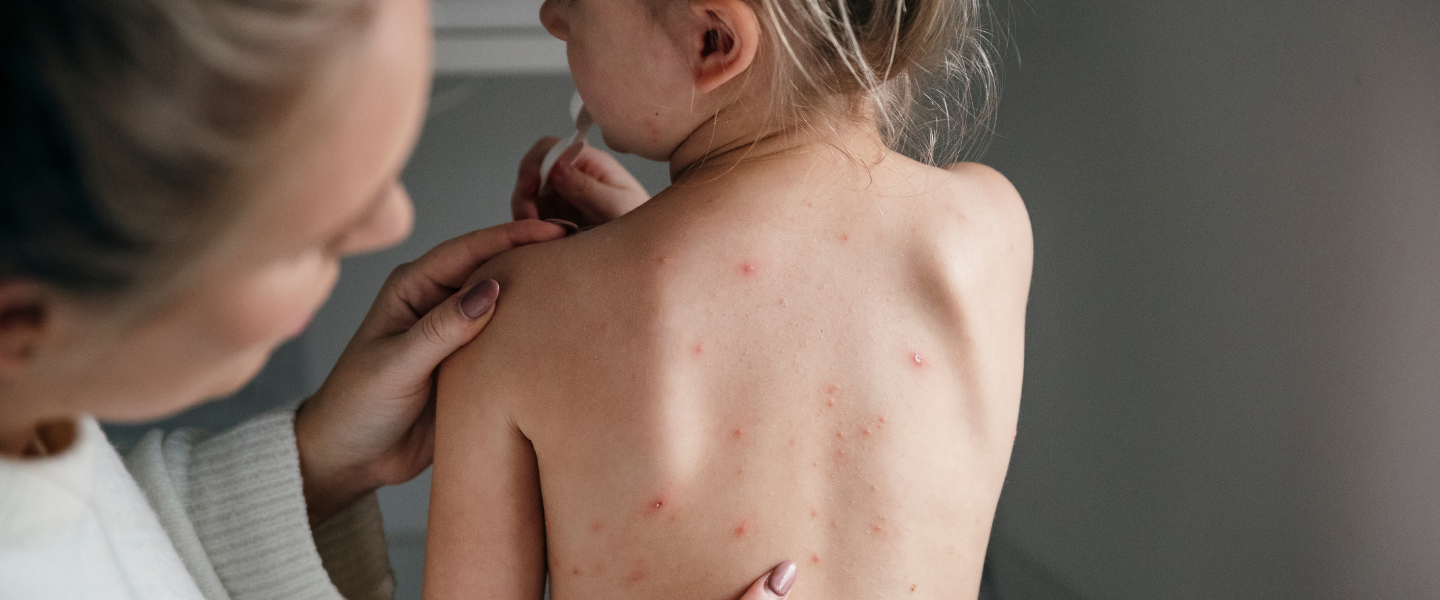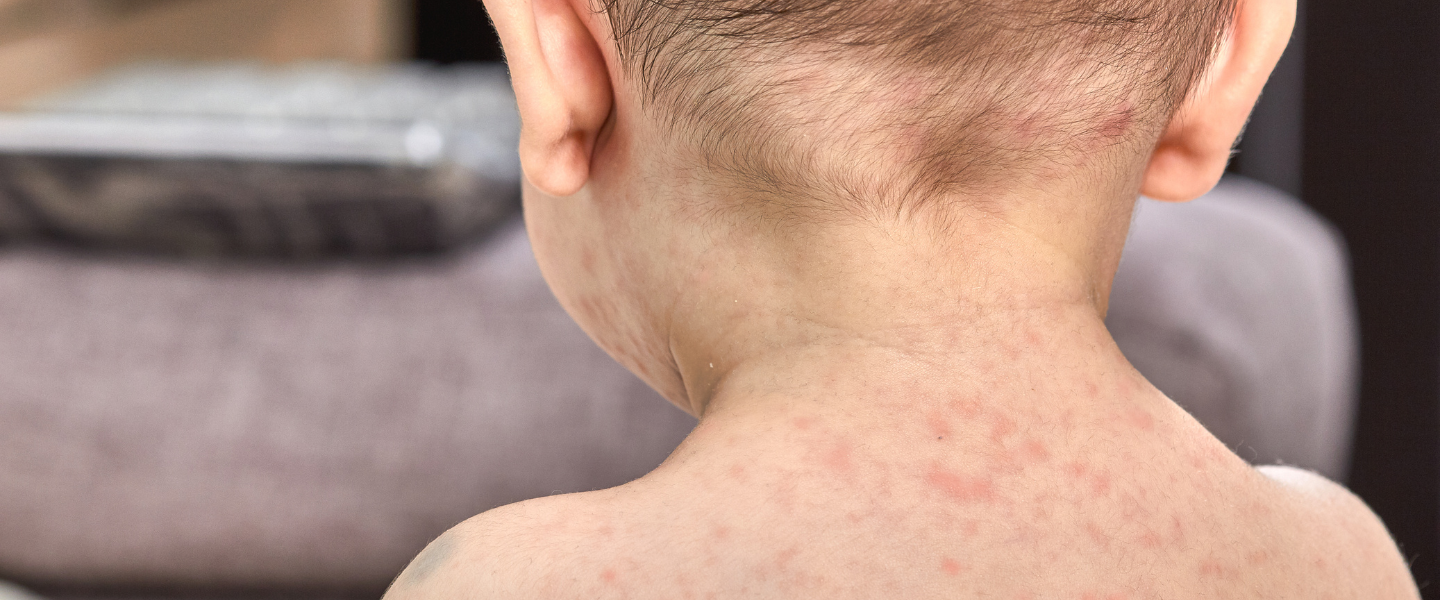- Home
- Health Topics
- Infectious Disease — Prevention and Control
- Infectious Diseases – Guidelines for Schools
Infectious Diseases – Guidelines for Schools
Students and staff may be exposed to a variety of communicable diseases and illnesses during their years in school settings.
If a student is sick, or if a school staff member is sick, please have them stay home – break the chain of infection by stopping exposure to illness.
This online self-assessment can be used by school staff and families to determine if they have any symptoms of illness or tested positive for COVID-19. At the end of the assessment, users will get a recommendation on what to do next.
If a child/student or staff is having any of the following symptoms, they should automatically be excluded from attending:
- Fever 38.0°C or higher – stay home until the fever is gone and feeling better for at least 24 hours
- Respiratory symptoms that are new or unusual – stay home for 24 hours minimum (this includes cough, runny nose, nasal congestion, sore throat, and shortness of breath)
- Gastro symptoms (e.g. nausea, vomiting, diarrhea) that are new or unusual – stay home for 48 hours after symptoms have stopped
Measles Toolkit for Schools and Childcare Centres
School principals are required, under the Health Protection and Promotion Act, R.S.O., 1990, Chapter H7, to report any student that is suspected or confirmed to be ill with a disease of public health significance to the Medical Officer of Health.
The public health system depends upon these reports of communicable diseases to monitor the health of the community and to provide the basis for preventive action.
Important: It is not necessary for schools to report other less urgent diseases such as hepatitis, lyme disease or sexually transmitted infections. These diseases are already reported to Public Health by laboratories and community physicians as required by provincial law.
Also, individual cases of common childhood illnesses such as pink eye, hand foot and mouth disease or ring worm are not reportable to Public Health unless special surveillance is being conducted on one of these diseases.
Report the following suspected or confirmed diseases to the Medical Officer of Health by telephone or fax as soon as possible.
Diseases marked with an asterisk (*) require immediate Public Health follow up. (Health Protection and Promotion Act, O. Reg. 135/18, O. Reg. 569)
- Acquired Immunodeficiency Syndrome (AIDS)
- * Acute Flaccid Paralysis (AFP) (under age 15)
- Amebiasis
- Anaplasmosis
- * Anthrax
- Babesiosis
- Blastomycosis
- *Botulism
- *Brucellosis
- Campylobacter enteritis
- * Carbapenamase-producing Enterobacteriaceae (CPE) (colonization or infection)
- Chancroid
- *Chickenpox (Varicella)
- Chlamydia trachomatis infections
- * Cholera
- * Clostridium difficile infection (CDI) outbreaks in public hospitals
- * Creutzfeldt-Jakob Disease, all types
- Cryptosporidiosis
- Cyclosporiasis
- *Diphtheria
-
Echinococcus multilocularis infection
- * Encephalitis, including
- Primary, viral
- Post-infectious
- Vaccine-related
- Subacute sclerosing panencephalitis
- Unspecified
- *Food poisoning, all causes
- *Gastroenteritis, outbreaks in institutions and public hospitals
- Giardiasis, except asymptomatic cases
- Gonorrhea
- *Group A Streptococcal disease, invasive
- Group B Streptococcal disease, neonatal
- *Haemophilus influenzae disease (all types), invasive
- *Hantavirus Pulmonary Syndrome
- *Hemorrhagic fevers:
- *Ebola virus disease
- *Lassa fever
- *Marburg disease
- *Other viral causes
- Hepatitis, viral
- *Hepatitis A
- Hepatitis B
- Hepatitis C
- * Influenza (novel, non-seasonal)
- *Legionellosis
- Leprosy
- *Listeriosis
- Lyme Disease
- *Measles
- *Meningitis, acute
- *Bacterial
- Viral
- Other
- *Meningococcal disease, invasive
- Mumps
- Novel Coronaviruses
- COVID-19
- * SARS
- * MERS
- * Ophthalmia neonatorum
- * Paralytic Shellfish Poisoning (PSP)
- Paratyphoid Fever
- Pertussis (Whooping Cough)
- *Plague (Yersinia pestis)
- Pneumococcal disease (Streptococcus pneumoniae), invasive
- *Poliomyelitis, acute
- Powassan Virus Infection
- * Psittacosis/Ornithosis
- *Q Fever
- *Rabies
- *Respiratory infection outbreaks in institutions and public hospitals
- * Rubella
- Rubella, congenital syndrome
- Salmonellosis
- * Shigellosis
- *Smallpox, and other Orthopoxviruses, including:
- Monkeypox
- Syphilis
- * Tetanus
- Trichinosis
- *Tuberculosis, active cases (also report positive skin tests in mm)
- *Tularemia
- Typhoid Fever
- *Verotoxin-producing E. coli infection indicator conditions, incl. Haemolytic Uraemic Syndrome (HUS)
- West Nile Virus illness
- Yersiniosis
To report a suspected or confirmed disease of public health significance, call the HNHU School Health Team at 519-426-6170 ext 3285.
When reporting, include the following details:
- Student’s name
- Parent/guardian’s name
- Date of birth
- Disease (specify if suspect or confirmed)
- Student’s address
- Telephone number for parent/guardian and/or students 14 years of age or older
- Physician‘s name (if known)
- Name of person reporting, school and contact information
Public Health's Role Includes:
- Investigating and managing reports of diseases of public health significance
- Making recommendations to healthcare providers on managing cases (people who get sick) and contacts of cases
- Offering immunization and recommendations on preventative medication/immunization for case contacts (people in contact with those who are sick)
- Providing guidelines for how long sick students and staff should be kept home from school or work
- Providing advisories for diseases of public health significance to the school for students, parents and staff
Staff Illness
The Health Protection and Promotion Act does not require that principals report illness of staff members to public health.
Chickenpox Reporting
The diagnosis of chickenpox does not need to be confirmed by a physician and the health unit does not need to speak with the parent. Report the following information for chickenpox only:
- Name
- Date of birth
Once chickenpox is identified in your school, we may recommend:
- Advising the school community (teachers, parents) of the incidence of chickenpox in the school
- Sending a chickenpox fact sheet and notification letter out to the school community
What is it?
- Chickenpox is a common, preventable infection caused by the varicella-zoster virus. Chickenpox is often characterized by its contagious, itchy rash.
- The infection is usually mild in children. But newborn babies and adults can become very sick if they get chickenpox.
- Chickenpox is most common in the late winter and early spring.
Signs and symptoms
- Begins with a mild fever followed by small, fluid-filled spots that show up all over the body.
- Spots commonly occur in successive crops and crust over in four to five days.
- Some people have only a few blisters. Other people can have hundreds.
- The chickenpox rash is very itchy.
How is it spread?
Chickenpox spreads easily. It jumps from person to person in two ways:
- Through direct contact with the virus, when someone touches the blisters.
- Through saliva droplets in the air, when someone with chickenpox sneezes, coughs, or even talks.
- The virus spreads most easily one or two days before the rash appears.
- A child with chickenpox can give the infection to other people until the blisters have dried up.
Long term
- The virus that causes chickenpox remains in our bodies without causing any problems
- When we get older or when our immune system becomes weakened, the virus can reappear and cause shingles.
- Shingles are very painful.
How to decrease the spread?
- There is a vaccine to prevent chicken pox. To find out more about this vaccination, contact your Health Care Provider or Public Health
- Take good care of the skin and make sure your child does not scratch it.
- A child who scratches a lot may get infections caused by bacteria that get into the skin.
Pregnant women
Pregnant women can develop severe chickenpox and pass it on to their unborn baby or newborn after birth.
- Mothers with chickenpox can also give it to their newborn babies after birth
- Consult your doctor as soon as possible if you are thinking of getting pregnant and have not had chickenpox.
- If you are exposed to chicken pox, call your doctor right away. A blood test can determine if you have the antibodies to protect you from the virus
Recommended Absence:
- Students and staff with mild illness may return to school and/ or daycare as soon as they are well enough to participate in normal activities, regardless of the state of the rash.
- Chickenpox must be reported to the Medical Officer of Health as required by the Health Promotion and Protection Act.
Resources: www.caringforkids.cps.ca
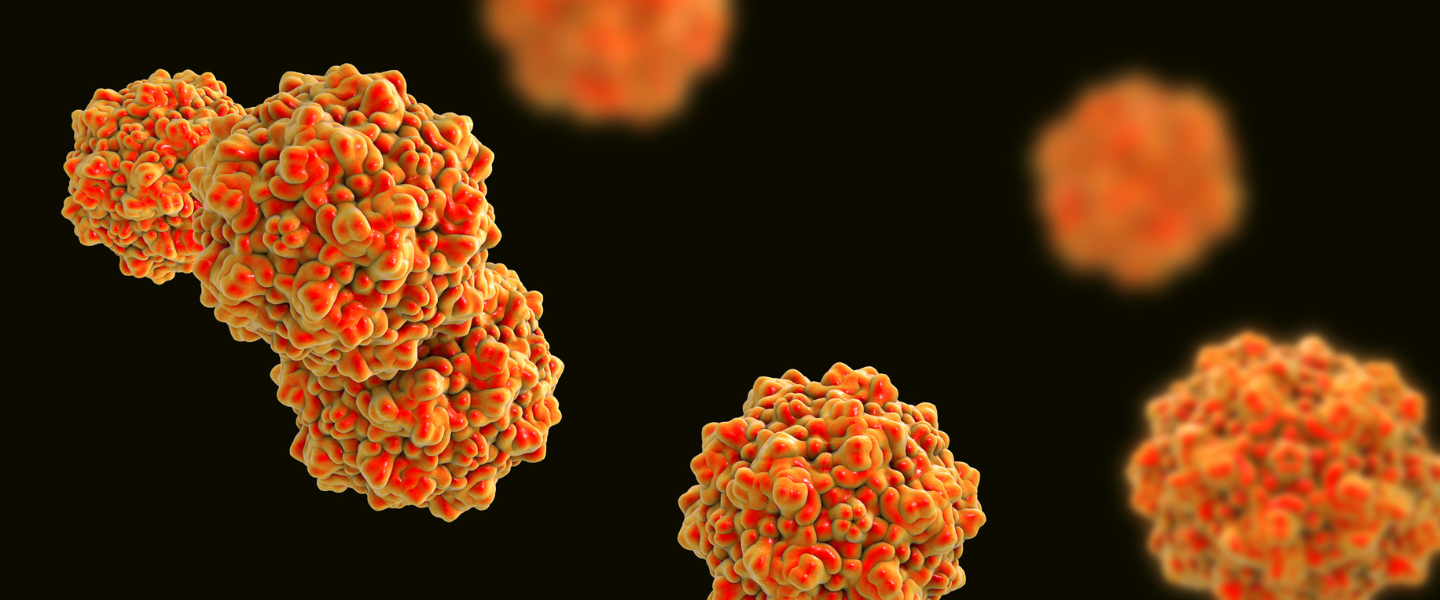
What is it?
- Fifth disease is sometimes called “slapped cheek” syndrome because of the red rash it causes. It is a common infection of the airway and lungs.
- It’s most common in late winter to early spring.
Signs and symptoms
- There may be no symptoms or mild symptoms that may include: Low-grade fever, headache, mild cold-like symptoms, upset stomach, and sometimes joint pain or swelling.
- It starts as a very red rash on the cheeks that looks like the face has been slapped.
- After 7 to 10 days, a red, lace-like rash appears, first on the torso and arms, and then spreads to the rest of the body.
- The rash may last from 1 to 3 weeks, the rash may come and go. It can be worse with changes in temperature, exposure to sun, and exercise.
How does it spread?
This virus spreads:
- By touching the hands of someone who has the infection and then putting your hands in your mouth.
- By touching an object (such as a toy) that has been touched by someone who has the infection and then putting your hands in your mouth.
- By coming in contact with the virus in the air, after an infected person has coughed or sneezed.
- The virus is most contagious a few days before the rash starts. Once the rash appears, your child can no longer pass it to anyone else.
- This virus can spread from a pregnant woman to her unborn child.
How to decrease the spread?
- Handwashing is the best way to prevent the spread of infection.
- Careful disposal of used facial tissue.
- Not sharing drinking cups or eating utensils.
- Covering nose and mouth while coughing and sneezing.
Pregnant Women
- If you’re pregnant and develop a rash or have sore joints and have been exposed to someone with fifth disease (or to anyone with an unusual rash), call your health care professional.
Recommended Absence:
- Only when the child is not well enough to participate or according to your policy.
- Your child can attend school while they have the rash. Fifth disease is not reportable to Medical Officer of Health.
Resources:
- www.aboutkidshealth.ca
- www.caringforkids.cps.ca
What is it?
- Rubella, commonly known as German measles is caused by a virus.
- Infection that affects the skin and lymph nodes.
- Usually a mild illness, but it can cause severe birth defects if a pregnant woman is infected.
- It is rarely diagnosed in Canada because most people are immunized. Your child is more likely to develop measles if they have not been vaccinated or if they travel to other countries without being vaccinated.
Signs and Symptoms
Common symptoms of rubella include:
- Slight fever
- Swollen lymph nodes at the back of the neck and behind the ears
- A non-itchy rash consists of tiny pink spots that become paler when pressed
- The rash usually appears after a few days of fever and feeling unwell
- Joint pain is common in adolescent and adult women and usually occurs after the rash and may last for a few weeks
- Not all cases of this condition look the same and many conditions can look similar. For information about your child’s illness, please speak to your child’s doctor.
How does it spread?
- The Rubella virus passes from person to person through coughs, sneezes or touched surfaces.
- Rubella is most contagious a few days before and after the rash appears.
How to decrease the spread?
- Rubella is included in the measles, mumps and rubella (MMR) vaccine.
- Ask your doctor if you or your child are not immune.
Pregnancy and fetal development
- Rubella in pregnancy is now very rare in Canada because most women have been vaccinated against it.
- If a pregnant woman gets rubella during the first 20 weeks of pregnancy, she usually passes the disease on to her unborn baby (fetus). The baby will have congenital rubella.
- If the fetus gets rubella during the first 12 weeks of pregnancy, the baby will likely be born with many life-long problems. The most common are eye problems, hearing problems, and damage to the heart and other organs.
- If the fetus gets rubella between 12 and 20 weeks of pregnancy, problems are usually milder
- There are rarely problems if the fetus gets rubella after 20 weeks of pregnancy.
- Babies with congenital rubella are contagious for more than a year. There is no treatment for rubella infection.
Recommended Absence
- Anyone with rubella must stay away from daycare, school and work for at least seven days after the appearance of the rash. Rubella must be reported to the Medical Officer of Health as required by the Health Promotion ad Protection Act.
Resources:
- About Kids Health www.aboutkidshealth.ca
- Caring for Kids www.caringforkids.cps.ca
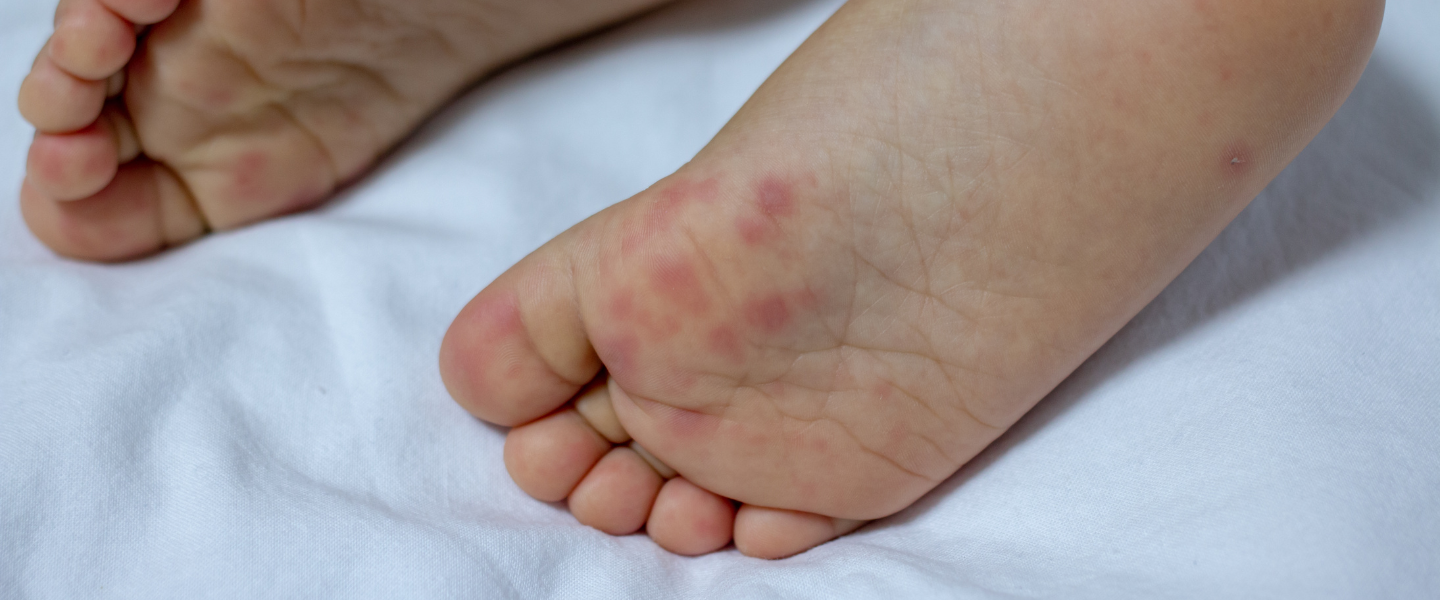
What is it?
- Both hand, foot and mouth disease and herpangina are infections caused by the Coxsackie virus.
- In Herpangina small red spots that become ulcers appear at the back of the mouth.
- In hand, foot and mouth disease, the rash can appear as small red, blisters on the hands, feet, mouth or diaper area.
- Both illnesses can be very painful and may cause your child to refuse food and water.
- The spots and ulcers in both illnesses will go away on their own within 10 days.
- Mostly affects young children, however, it can happen at any age.
- Most common in the summer and fall.
Signs and Symptoms
- A skin rash with red spotted small blisters which appear on the hands (palms) and feet (soles), buttocks and sometimes other places on the body.
- Do not pop any blisters; they will heal on their own.
- Fever
- Headache
- Sore Throat
- Loss of Appetite
- Lack of energy
- Vomiting and/or diarrhea
- Small, painful ulcers in the mouth
How does it spread?
- There is no vaccine against Coxsackie virus.
- Most contagious during the first week of illness.
- The incubation period for the virus is three to six days before the child is sick.
- Spreads through contact with an infected person’s saliva or stool.
- Germs can get on a person’s hands or other objects and then spread into someone’s mouth, causing infection.
- The virus can be found in a person’s stool for up to 4 weeks after the start of the illness.
- Hand, foot and mouth disease is not spread from animals.
How to decrease the spread?
- Handwashing is the best way to prevent the spread of infection.
- Key times to wash include:
- After wiping the child’s nose
- After changing a diaper
- After using the toilet
- Before preparing food
- The virus can also survive on surfaces and objects, such as counters and toys, long enough to spread to another person- clean these surfaces on a regular basis.
Recommended Absence:
- Only when the child is not well enough to participate or according to your policy.
- Coxsackie virus is not reportable to the Medical Officer of Health.
Resources
About Kids Health — www.aboutkidshealth.ca
Caring for Kids — www.caringforkids.cps.ca
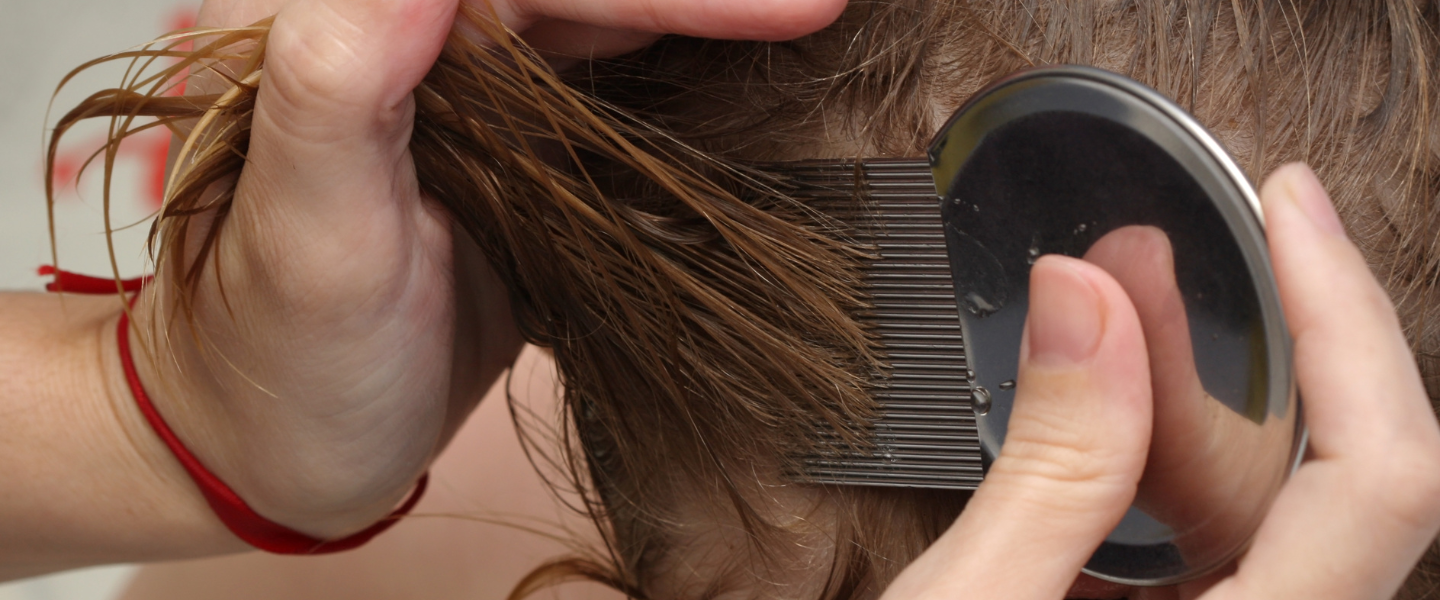
What are head lice?
- Head lice are tiny insects that live on the scalp, where they lay eggs.
- They do not jump, fly, swim, or live on cats or dogs but can crawl very quickly.
- Head lice are common in school-aged children.
- They are not a health concern or a communicable disease.
- They are also not associated with illness or poor hygiene.
Symptoms
- Ticklish or itchy feeling on the head.
- Feeling something moving in the hair.
- Frequent head-scratching
How do I know if my child has lice?
-
In very bright light look behind the ears, near the neck and close to the scalp for small insects moving in hair (lice), and small eggs (called nits) that are attached to the hair near the scalp.
How to Prevent Lice
- Lice spread from one person to another when there is close head-to-head contact or when items that have touched the hair of someone who has lice are shared.
Do not share personal items such as:
- brushes and combs
- hair bands, ties, and elastics
- headphones
- hats or helmets
- scarves or towels
Treatment of Head Lice
- Lice shampoo products have been shown to be the most effective method for getting rid of head lice.
- Do not treat anyone with a head lice product unless you find live lice in their hair.
- Before using any head lice shampoo product, read the product inserts and carefully follow the instructions on the package.
- For non-chemical treatment options, speak to your doctor, pharmacist or health care provider.
- Also, speak to your healthcare provider if your child has head lice and:
- is under 2 years old
- has a seizure disorder
- has lice or nits on their eyebrows and eyelashes
- has open sores or wounds on the scalp
- has allergies
- If you are pregnant or breastfeeding, call Motherisk at 1-877-439-2744 for more information.
Cleaning Your Home
- Head lice can live up to 24 hours off the head.
- Pay special attention to items that directly touch the head such as hats, pillowcases, car seat covers, combs and brushes.
- Wash these items in hot water and dry them in a hot dryer for at least 15 minutes or store the items in an airtight plastic bag for two weeks.
Reference: www.caringforkids.cps.ca
What is it?
- Impetigo is a common childhood skin infection that is usually caused by bacteria called group A streptococcal (strep) or Staphylococcus aureus (staph).
- Infection happens when the bacteria enters the skin through an open area (like a bug bite) or scrape.
Sign and Symptoms
- Impetigo usually appears around the mouth, nose or on the skin, that’s not covered by clothes.
- The rash can start as a cluster of red bumps or blisters. Eventually, the blisters may ooze a honey-coloured crust. Many germs live under this crust.
- Sometimes the infection can become serious. If this happens, your child may have fever, pain, swelling, and may feel weak.
How is it spread?
- Direct contact: Impetigo can spread when someone touches the rash directly.
- Indirect contact: The germs can get on bed sheets, towels or clothing that have been in contact with someone’s skin. Then a person can pick up the germs from touching those objects.
- This infection can be spread as long as the sores continue to drain or until 24 hours after antibiotic treatment has started.
How to decrease the spread?
- Handwashing is the number one way to decrease the spread.
- Cover the areas that have the blisters/rash.
- Speak to your Health Care Provider for treatment.
Recommended Absence
- An infected child may return to school or daycare 24 hours after antibiotic treatment has been started.
- Impetigo is not reportable to the Medical Officer of Health.
Resources:
Caring for Kids www.caringforkids.cps.ca

Influenza, commonly known as the flu, is a respiratory illness caused by viruses that affect the nose, throat and lungs. Flu season, the peak time for influenza, is November through April each year.
The flu shot is your best defence to protect yourself and your family against the flu.
How do you get the flu?
The flu is spread from person to person through coughing or sneezing, or by touching surfaces that are contaminated with the virus.
To protect yourself from the flu you can:
- Frequently wash your hands with soap and running water, or use an alcohol-based hand sanitizer
- Frequently clean and disinfect common surfaces and items
- Stay home when you are sick
- Don’t touch your face
- Get your flu shot
Symptoms
Symptoms usually start one to four days after being exposed to the virus. Most people will recover in seven to 10 days. Individuals in high-risk groups could experience more severe complications.
You may have the flu if you have:
- Fever
- Chills
- Cough
- Runny nose
- Stuffy nose
- Sore throat
- Headache
- Muscle ache
- Extreme weakness and tiredness
Cold or Flu?
The flu is often confused with the common cold (rhinovirus).
Flu and the common cold are both respiratory illnesses but they are caused by different viruses. Because these two types of illnesses have similar symptoms, it can be difficult to tell the difference between them based on symptoms alone.
In general, the flu is worse than the common cold, and symptoms are more intense.
Complications
Flu-related complications can affect anyone but they are more common for those in a high-risk group. This includes:
- Older adults (people 65+ years)
- Children under five years old
- Pregnant women
- People with underlying health conditions
Complications from the flu can include pneumonia, which is a serious illness. It is estimated that the flu causes approximately 12,200 hospitalizations and 3,500 deaths in Canada each year.
Flu vaccine
Anyone aged six months and older who works, lives or goes to school in Ontario is eligible to receive the flu vaccine.
Where to get the flu shot:
- Health care providers
- Pharmacies (must have a health card and be five years of age or older)
- Walk-in clinics
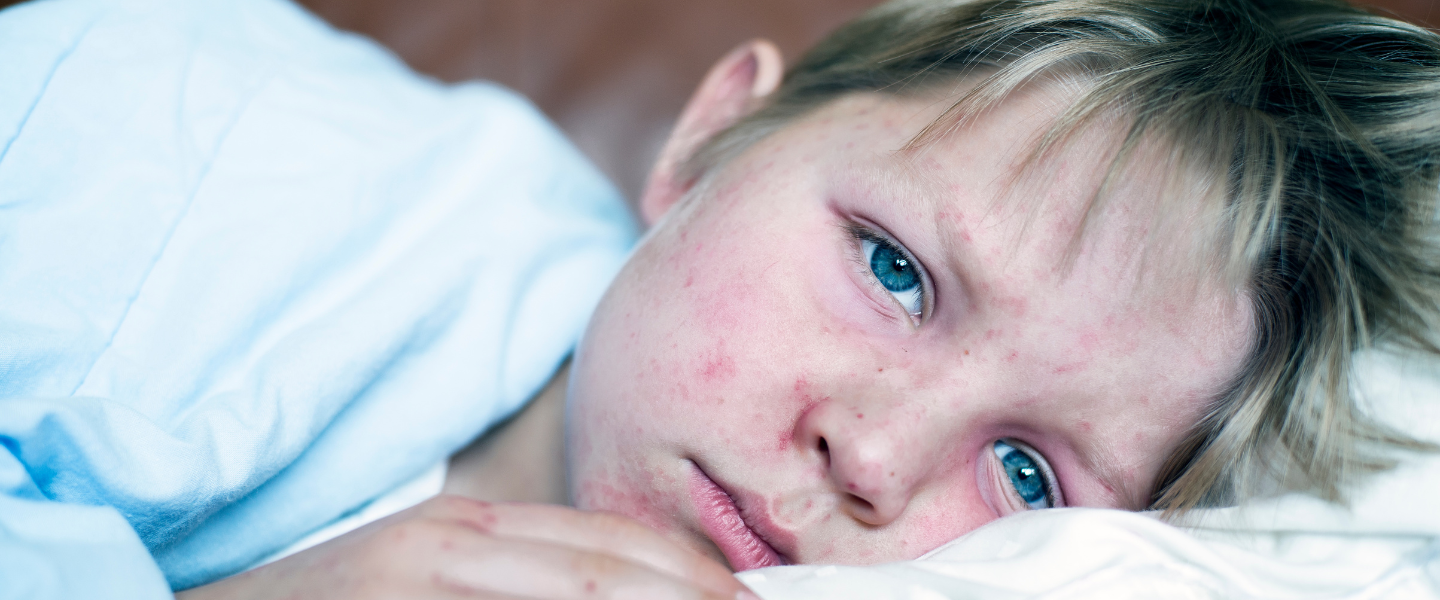
What are Measles?
- Measles is a highly contagious viral infection that spreads through the air when the infected person breaths, coughs or
sneezes.
Signs and Symptoms
- Fever that lasts for a couple of days
- Cough, runny nose, and red and watery eyes that follows the fever
- Small red spots with bluish-white centers inside the mouth (Koplick spots)
- Rash that starts on the face and upper neck and spread down the body before spreading to the arms, hands, legs and feet
How does it spread?
- Measles is mainly spread through the air. It can be caught just by being in a room with a person with measles or where someone with measles has been
recently - The virus can survive in the air for up to two hours
- The virus is very contagious up to 4 days before the rash or signs of illness starts
How do you prevent it?
- Vaccination against measles is the best way to prevent its spread
- If you are not vaccinated and want the vaccine, call the health unit at 519-426-6170 for a referral
- If you or someone you know develops symptoms of measles:
- Isolate the individual(s)
- Don’t go to work for at least 4 days after the appearance
of the rash - Contact the Health Unit at 519-426-6170
- If you need to visit a health care provider, call in advance to advise them of measles symptoms
Resources
Government of Canada https://www.canada.ca/en/public-health/services/diseases/measles.html
Caring For Kids caringforkids.cps.ca

What is it?
Infectious mononucleosis is a common viral illness caused by Epstein-Barr virus (EBV). It occurs worldwide and is often diagnosed in the teenage and young adult population due to the social behaviours of this age group. In young children, the disease is usually very mild and more difficult to diagnose. By adulthood, at least 90% of people have been exposed to the virus and are immune.
What are the symptoms?
Symptoms of mononucleosis include sore throat, fever, swollen and tender lymph glands and enlarged spleen. The most common symptom is severe sore throat lasting three to five days which usually resolves in seven to 10 days. The onset of illness can be abrupt, but often will appear gradually over several days, with chills, sweats and loss of appetite.
How is it spread?
The virus is spread from person to person through saliva. Kissing, and sharing items like eating utensils or drink containers, lipstick, cigarettes or musical instruments with mouthpieces are all common sources of spread. Transmission of this virus through air or blood does not normally occur. Symptoms appear four to six weeks after contact with the virus. People with mononucleosis may be able to spread the virus to others for a prolonged period of time. However, since the virus is also frequently found in the saliva of healthy people, no special precautions are recommended. Many healthy people carry this virus throughout their lifetimes without even knowing it. Therefore, the spread of infectious mononucleosis is almost impossible to prevent.
Recommended absence
A person may return to school or work when he or she is feeling well enough to participate in normal activities without tiring. This varies from case to case, depending on the severity of the illness. Rest is an important part of recovery. Too early a return to activities may result in a prolonged recovery time. Mononucleosis infection is not reportable to Medical Officer of Health.
Resources:
www.aboutkidshealth.ca
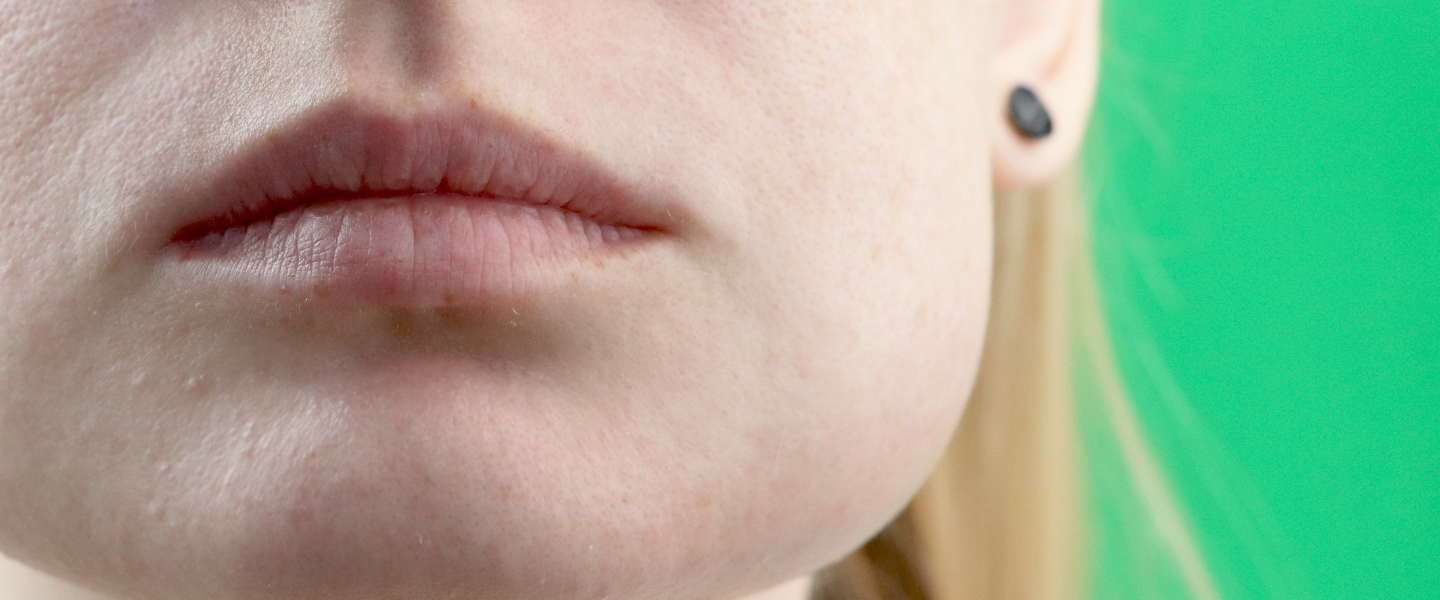
What is it?
- Mumps is a disease caused by a virus which is rare due to the introduction of the vaccine in 1969.
- Usually occurs in school-aged children, although it can occur at any age.
Signs and Symptoms
- Mumps causes fever, aches and pains, headaches and swelling of the salivary glands around the jaw and cheeks.
- Swelling is painful and makes the cheeks puff out.
- The glands usually become more swollen and painful over 1 to 3 days.
- Chewing and swallowing can become painful. • Some children infected with mumps have no symptoms at all, or may seem to have a cold, but can still spread the infection to others.
- In severe cases, mumps can cause meningitis, a serious disease that infects the fluid around the brain and spinal cord or encephalitis (swelling in the brain). This can lead to seizures, hearing loss, or death.
- Older boys and men sometimes get orchitis (painful swelling of the testicles), which can cause sterility (unable to get a woman pregnant).
- Women may have a painful infection of the ovaries, but it does not prevent pregnancy.
How is it spread?
- Mumps virus is spread through the air by coughing or sneezing or by droplet contact with the discharges from the nose and throat of an infected person.
- It can also be spread by direct contact with the saliva of an infected person.
- The virus is present in these discharges from 7 days before until 5 days after the onset of swelling of the glands.
- One person out of three who has mumps will not have any symptoms. How to decrease the spread?
- Most people today are immune to mumps because they were vaccinated against the disease.
- In Canada, adults born before 1970 are presumed to have acquired natural immunity to mumps.
Pregnancy and fetal development
- If a pregnant woman is exposed to mumps she should consult her physician.
- Mumps infection in the first trimester (three months) of pregnancy can cause spontaneous miscarriage.
Recommended absence
- All people with confirmed mumps are to be excluded from school or daycare until five days after the onset of swelling.
- Mumps must be reported to the Medical Officer of Health as required by the Health Promotion and Protection Act.
Resources
- Public Health Agency of Canada
- About Kids Health
- Caring for Kids www.caringforkids.cps.ca

What is it?
- Norovirus is a very contagious source of non-bacterial diarrhea and vomiting.
- The illness can occur at any time of the year but is most common in the fall and winter months.
- Norovirus outbreaks commonly occur in areas where people are in close proximity to one another such as nursing homes, childcare centres, banquets, cruise ships, schools, and restaurants.
Signs and Symptoms
- Sudden onset includes watery diarrhea, nausea, vomiting, stomach cramps, headache, or low-grade fever.
- Can last for 24 to 48 hours. The virus can be spread up to 48 hours after the symptoms stop and in some people up to two weeks.
How is Norovirus spread?
- Norovirus is found in the feces or vomit of infected people.
- Others can become infected with the virus by direct contact with the person who is ill and by touching contaminated surfaces or objects e.g. door handles, and shopping carts.
- Contaminated water, raw shellfish and other foods have also been identified in outbreaks.
How to decrease the spread?
- Thorough hand washing is the best prevention. Make sure that the hands are thoroughly washed after using the toilet, changing diapers, and before preparing food.
- Immunity following the infection is usually short term lasting up to 14 weeks.
- Any clothing or linens that have been contaminated should be carefully removed as soon as possible and washed in a hot water cycle at the maximum length of time.
- Persons ill with norovirus should avoid being around others.
- If you think you are infected with norovirus, do not prepare food for other people.
Recommended absence:
- Stay home if you are ill.
- If you are an employee of an institution, daycare or daycare attendee, or you are a food handler, further restrictions may include staying home until you are symptom-free for a 48-hour period.
- Norovirus is not to be reported to the Medical Officer of Health as required by the Health Promotion and Protection Act.
Reference
https://www.canada.ca/en/public-health/services/food-poisoning/ norovirus.html

What is it?
- Pertussis, also called whooping cough, is an infection in the airways caused by bacteria.
Signs and symptoms
- Symptoms start as a common cold with
- Sneezing, runny nose, mild fever and a mild cough
- The cough gets progressively worse.
- The cough is severe, repeated and forceful.
- The coughing periods are often followed by vomiting and/or a whooping sound before the next breath.
- Cough may be absent in very young infants. It may appear as a pause in their breathing.
- The cough can last many months and is more common at night.
- Whooping cough can cause pneumonia, seizures, brain damage or death.
How is it spread?
- It is spread by breathing the air of a person who has the infection.
- It can be spread by touching the saliva or mucus of a person who has the bacteria.
- Without medicine, pertussis can be shared a few days before a person has a cough and up to three weeks after the cough starts.
- A person with whooping cough will be given antibiotics. Household members may be given antibiotics depending on the assessment completed by their healthcare provider.
- An infected child should not return to school until they have taken antibiotics for 5 days and feel well enough to return.
How to Decrease the Spread?
- The best way to protect yourself and others is to be vaccinated. Some people who have been vaccinated may still get pertussis but is a milder form of the disease than those who have not been vaccinated.
- Wash your hands often. Avoid your touching face, nose and eyes.
- Use good coughing technique by coughing into your sleeve.
Pregnant women
- Pregnant women in their third trimester and infants under one, regardless of their vaccination status, are at the highest risk of complications and should be treated with antibiotics. Call your Health Care Provider.
Recommended Absence
- 5 days after treatment with appropriate antibiotics
- If untreated, approximately 3 weeks
- Pertussis must be reported to the Medical Officer of Health as required by the Health Promotion and Protection Act.
Resources
www.caringforkids.cps.ca
Government of Canada (gov.on.ca)

What is it?
- Pinkeye is an infection of the covering of the eyeball and the inside of the eyelid.
- Pink eye is most often caused by viral infections associated with the common cold.
- It can also be caused by bacterial infections or allergies. Children with bacterial pink eye should take antibiotic drops or ointment. These are not needed for viral pink eye. • Viral and bacterial pink eye are contagious. • Pink eye should not cause any long-term damage to a child’s vision. • Seek medical attention if there is a change in vision, persistent redness, eye pain, or eyelid swelling.
Signs and Symptoms
- Complaints of a scratchy feeling or pain in their eyes and may have a lot of tears and pus discharge.
- The infection turns the whites of the eyes pink or red.
- When the child wakes up after a sleep, pus or discharge often makes the eyelids stick together.
- The time of contact to the time of first symptoms is usually 12 to 24 hours.
- Your child may have:
- eye and inner eyelid redness
- slightly swollen eyelids
- itchy eyes
- clear or yellow-green eye discharge
- Viral pink eye usually affects both eyes. Your child may also have other cold symptoms.
- Bacterial pink eye often affects only one eye at first.
- You will be able to see yellow or green discharge.
- Allergic pink eye may occur when your child is allergic to something in the environment. Your child may have a ragweed pollen, tree pollen, grass or animal allergy.
- It affects both eyes and there is little or no discharge. Your child may have itchy and watery eyes.
How is it spread?
- Pinkeye is spread by droplets from the nose or throat of an infected person.
- It can also be spread by contact with the discharge from infected eyes, either by the infected person touching the discharge and then another person, or by the uninfected person touching the discharge and then touching their own eye(s).
- A person is contagious throughout the course of active infection or until 24 hours after antibiotic treatment has been started.
How to decrease the spread?
• Hand washing prior to touching your face is the best way to decrease the risk of exposure.
Recommended absence
- Persons who have pinkeye should be absent from work, school or daycare until 24 hours after antibiotic treatment has been started or as directed by the healthcare provider if antibiotics are not prescribed.
- Conjunctivitis is not to be reported to the Medical Officer of Health as required by the Health Promotion and Protection Act.
Resources
About Kids Health www.aboutkidshealth.ca
Caring for Kids www.caringforkids.cps.ca

What is it?
Pinworms are tiny, white, thread-like worms that live in the rectum.
Signs and Symptoms
- The worms crawl out of the anus (bum) at night and lay their eggs on nearby skin.
- Pinworms can be uncomfortable but they do not cause disease.
- Some children get very itchy around the anus and vagina, especially at night. If the infection is bad, your child can lose sleep and become cranky.
- Pinworms are white, thin, wiggly worms that measure about one-quarter of an inch in length and cause itching, irritation and discomfort.
- If your child has pinworms, their doctor can prescribe a special medication to treat the problem.
How does it spread?
- They are very common in children and spread easily among children in childcare.
- Directly: An infected person who scratches the itchy area can get pinworm eggs on the fingers or under the fingernails. If that person touches another person’s mouth, they will spread pinworms.
- Indirectly: Eggs can get from an infected person onto objects, such as toys, toilet seats or baths, clothes or bedding.
- By sharing these objects, other people can pick up the eggs on their hands and then put them into their mouth.
- Eggs can live for up to 2 weeks outside the body, on clothing, bedding or other objects.
How to decrease the spread?
- Pinworms can come back if your child comes into contact with pinworm eggs again. They can stay alive in your home for up to 2 to 3 weeks.
- Make sure everyone in your family washes their hands carefully after going to the toilet, changing diapers, and before preparing or eating food.
- Wash your bed linens and clothes. Don’t shake them because this can scatter the eggs.
- Keep everyone’s fingernails short and avoid nail-biting.
- The eggs are sensitive to sunlight. Open blinds or curtains in bedrooms during the day when your child isn’t sleeping.
- A child can develop a pinworm infestation if they swallow pinworm eggs. The worm usually develops about three to four weeks after the egg has been swallowed.
Recommended absence
- There is no recommended absence for pinworms.
- Pinworms is not reportable to the Medical Officer of Health
Resources
About Kids Health www.aboutkidshealth.ca
Caring for Kids www.caringforkids.cps.ca
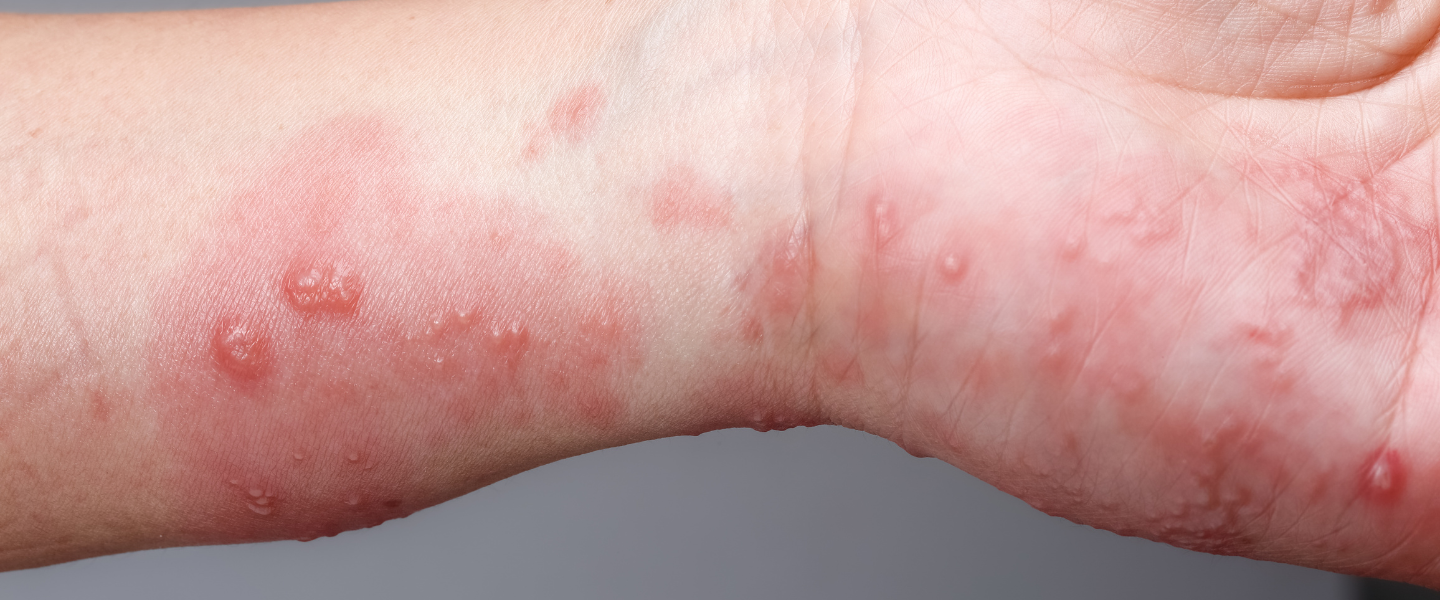
What is it?
- Scabies is a condition caused by tiny insects called mites. Scabies is a nuisance, not an infection.
- The condition is common in children, but anyone can get it. Scabies has nothing to do with cleanliness.
Signs and Symptoms
- The mites that cause scabies burrow into the skin and cause a very itchy rash that gets worse at night.
- The rash looks like curvy white threads, tiny red bumps, or scratches, and can appear anywhere on the body.
- It often appears between fingers or around wrists or elbows. On an infant, it can appear on the head, face, neck and body.
How is it spread?
- Scabies spreads from person to person by touch, or by contact with clothing or other personal items of someone with scabies.
How can you decrease the spread?
- Scabies can be treated with medication recommended by a physician.
- A child may still be itchy for a few weeks after the treatment has eliminated the mites.
- This means that the child is reacting to the mites, not that the treatment has failed to get rid of them.
- Washing the clothes in hot water and then putting them in a hot dryer also helps to get rid of the mites.
Recommended absence
- Your child should not return to school or daycare until treatment has been given.
- Scabies is NOT reportable to the Medical Officer of Health.
Things parents can do
- Watch your child closely for signs of scabies if another child has it.
- Contact your physician if you think your child has scabies.
- If the physician determines that your child has scabies, every member of your household will probably have to be treated with medication. Be sure to follow the instructions on the bottle.
- If your child has scabies, wash the child’s bed linen, towels and clothes in hot water, and dry in a clothes dryer at the hottest setting.
- If your child has scabies, he or she should not return to the school or childcare facility until treatment has been given
- Use of insecticide sprays for the household is not indicated. Transfer of the scabies mite occurs only through skin-to-skin contact or through contact with objects recently infected.
References
aboutkidshealth.ca
caringforkids.cps.ca
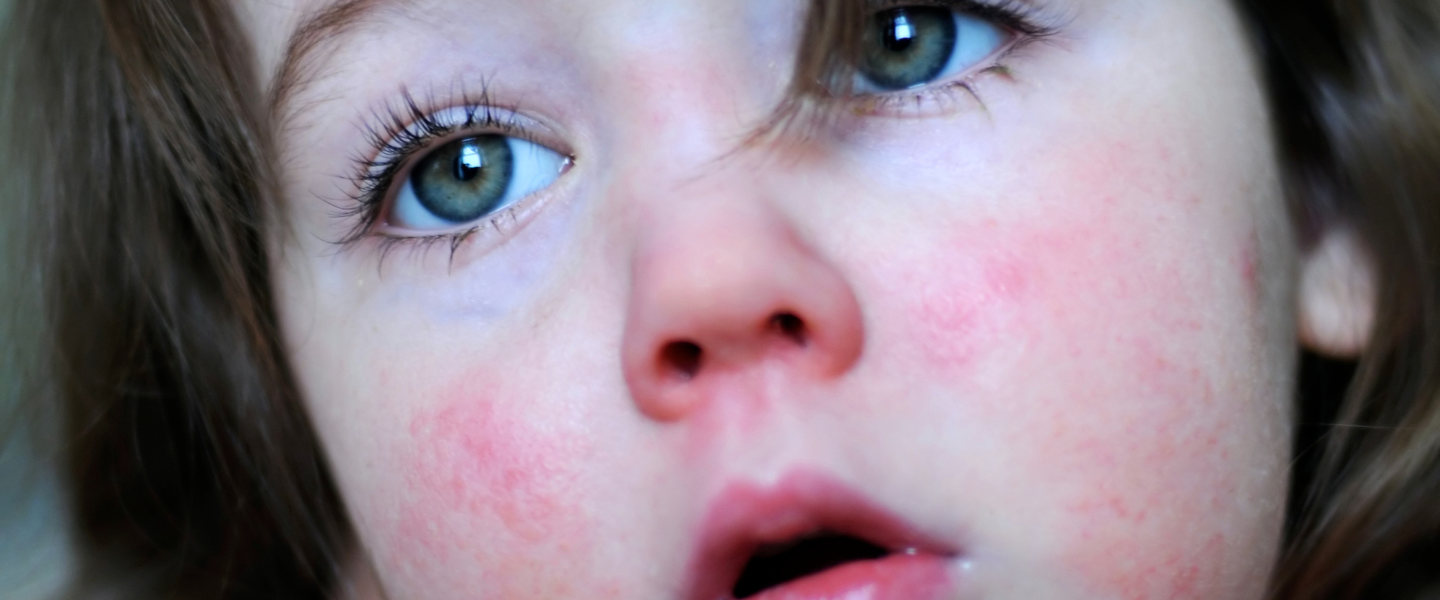
What is it?
- Scarlet fever is a bacterial infection caused by Group A Streptococcus which is commonly found on the throat and skin and also causes strep throat
Signs and Symptoms
- Scarlet fever usually begins with a red, sore throat with white patches, similar to strep throat, a high fever, a red, swollen strawberry tongue, nausea, and sometimes vomiting.
- A fine, red, pinpoint rash (normal bumps on the tongue look bigger) (that feels like sandpaper) appears within two days after the sore throat and fever.
- The rash most often appears on the neck, chest, under the arms, elbow, groin and on the inner surfaces of the thighs.
- The face is flushed, but free of rash, and the area around the mouth is pale. The rash fades when you press the skin, which peels off sometimes in large sections, especially on the palms and soles. There may also be a reddish rash on the inside of the mouth.
How is it spread?
- It is spread by contact with other people's infected respiratory secretions.
What is the incubation period?
- The usual incubation period (time from exposure to the appearance of symptoms) is one to four days, but can sometimes be as long as seven days.
- A person is considered infectious until 24 hours after beginning antibiotics.
- Anyone who is untreated is probably infectious for about three weeks.
What is the recommended absence?
- After 24 hours of antibiotics and as soon as they have no fever and feel well, persons can return to school or daycare.
- Scarlet fever is reportable to schools and daycares.
Reference
https://www.canada.ca/en/public-health/services/infectious-diseases/ scarlet-fever-fact-sheet.html
aboutkidshealth.ca

What is it?
- While viruses are the most common cause of a sore throat, strep throat is a bacterial infection in the throat and tonsils caused by group A Streptoccoccus (group A strep).
- It is more common in children than adults and can cause a very painful sore throat
Signs and symptoms
- Symptoms may occur 2 to 5 days after a person is exposed to group A strep.
- Swallowing becomes very painful, and the tonsils can become red and swollen and may have white patches or streaks of pus.
- Other symptoms may include a headache, stomach pain, nausea and vomiting, especially in children.
- Sometimes children with Strep can develop a red rash all over the body that feels like sandpaper, this illness is called Scarlet Fever or “scarlatina”.
How is it spread?
- Group A strep live in the nose and throat and can easily spread to other people.
- It is important to know that some infected people (known as “carriers”) do not have symptoms or seem sick.
- People who are infected spread the bacteria by coughing or sneezing droplets containing the bacteria into the air.
- People can get sick if they breathe in those droplets or touch something with droplets on it and then touch their mouth or nose, or is they drink from the same glass or eat from the same plate as the sick person.
- A doctor can swab the throat and test for group A strep bacteria.
- If group A strep is causing the illness, antibiotics can be prescribed to treat the infection. Take the antibiotic exactly as prescribed, even if your child starts to feel better.
How to decrease the spread?
- Covering the mouth when coughing and sneezing, and washing hands after wiping or blowing the nose, and after coughing and sneezing can help prevent group A strep bacteria from spreading.
Recommended Absence
- People with strep throat should stay home from school or daycare until they no longer have a fever AND have taken antibiotics for at least 24 hours.
- Strep throat is not reportable to Medical Officer of Health.
Resources
www.aboutkidshealth.ca
www.caringforkids.cps.ca

